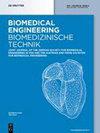Comparative evaluation of volumetry estimation from plain and contrast enhanced computed tomography liver images
IF 1.8
4区 医学
Q4 ENGINEERING, BIOMEDICAL
引用次数: 0
Abstract
Objectives Surgery planning for liver tumour is carried out using contrast enhanced computed tomography (CECT) images to determine the optimal resection strategy and to assess the volume of liver and tumour. Current surgery planning tools interpret even the functioning liver cells present within the tumour boundary as tumour. Plain CT images provide inadequate information for treatment planning. This work attempts to address two shortcomings of existing surgery planning tools: (i) to delineate functioning liver cells from the non-functioning tumourous tissues within the tumour boundary and (ii) to provide 3D visualization and actual tumour volume from the plain CT images. Methods All slices of plain CT images containing liver are enhanced by means of fuzzy histogram equalization in Non-Subsampled Contourlet Transform (NSCT) domain prior to 3D reconstruction to clearly delineate liver, non-functioning tumourous tissues and functioning liver cells within the tumour boundary. The 3D analysis from plain and CECT images was carried out on five types of liver lesions viz. HCC, metastasis, hemangioma, cyst, and abscess along with normal liver. Results The study resulted in clear delineation of functional liver tissues from non-functioning tumourous tissues within the tumour boundary from CECT as well as plain CT images. The volume of liver calculated using the proposed approach is found comparable with that obtained using Myrian-XP, a currently followed surgery planning tool in clinical practice. Conclusions The obtained results from plain CT images will undoubtedly provide valuable diagnostic assistance and surgery planning even for the subset of patients for whom CECT acquisition is not advisable.从普通和造影剂增强型计算机断层扫描肝脏图像估算容积的比较评估
目的 肝肿瘤的手术规划是通过对比增强计算机断层扫描(CECT)图像来确定最佳切除策略,并评估肝脏和肿瘤的体积。目前的手术规划工具甚至将肿瘤边界内的正常肝细胞也视为肿瘤。普通 CT 图像无法为治疗规划提供足够的信息。这项工作试图解决现有手术规划工具的两个缺陷:(i) 从肿瘤边界内的非功能性肿瘤组织中划分出功能性肝细胞;(ii) 从普通 CT 图像中提供三维可视化和实际肿瘤体积。方法 在三维重建之前,在非子采样轮廓变换(NSCT)域通过模糊直方图均衡化对包含肝脏的所有平扫 CT 图像切片进行增强,以清晰划分肿瘤边界内的肝脏、非功能性肿瘤组织和功能性肝细胞。对五种类型的肝脏病变,即 HCC、转移瘤、血管瘤、囊肿和脓肿以及正常肝脏进行了平扫和 CECT 图像的三维分析。结果 研究结果显示,CECT 和普通 CT 图像能清晰地划分出肿瘤边界内的功能性肝组织和非功能性肿瘤组织。使用所提出的方法计算出的肝脏体积与目前临床上常用的手术规划工具 Myrian-XP 计算出的肝脏体积相当。结论 从普通 CT 图像中获得的结果无疑将为诊断和手术规划提供有价值的帮助,即使是对于不宜采集 CECT 的部分患者也是如此。
本文章由计算机程序翻译,如有差异,请以英文原文为准。
求助全文
约1分钟内获得全文
求助全文
来源期刊
CiteScore
3.50
自引率
5.90%
发文量
58
审稿时长
2-3 weeks
期刊介绍:
Biomedical Engineering / Biomedizinische Technik (BMT) is a high-quality forum for the exchange of knowledge in the fields of biomedical engineering, medical information technology and biotechnology/bioengineering. As an established journal with a tradition of more than 60 years, BMT addresses engineers, natural scientists, and clinicians working in research, industry, or clinical practice.

 求助内容:
求助内容: 应助结果提醒方式:
应助结果提醒方式:


